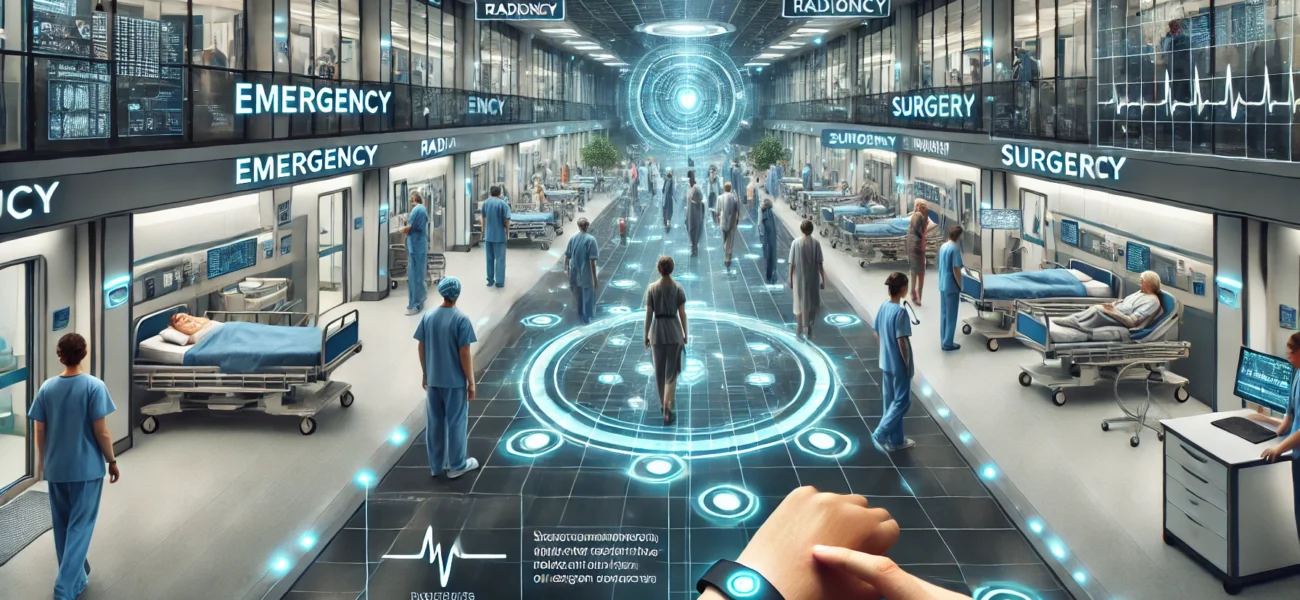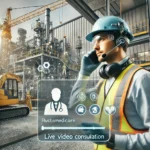At the heart of ERTriage system are smart wearable wristbands and a web-based triage platform:
Wearable Wristbands: Upon check-in, patients receive wristbands embedded with sensors to monitor all required protocol-based vital signs. Equipped with unique identifiers, these devices also track patient location via RFID or Bluetooth technology. Some wristbands feature displays or indicators to communicate instructions and updates to the patient.
Web-Based Triage System: This centralized software analyzes patient data in real-time. By leveraging artificial intelligence (AI), it evaluates the severity of conditions using patient-reported symptoms, historical data, and real-time sensor inputs. The system dynamically communicates with hospital departments to prioritize and route patients efficiently.
Seamless Registration and Data Collection
The process begins at registration, where patients provide initial information through reception desk. Details such as symptoms, medical history, and demographics are logged into the system. The wristbands are then activated and linked to the patient’s profile, enabling continuous monitoring and integration with the hospital’s network.
Dynamic and Automated Triage
The triage system continuously analyzes incoming data to determine patient priority levels:
Real-Time Data Analysis: Vital signs from the wristbands are monitored, and deviations from normal ranges trigger alerts. For instance, a rapid heart rate or low oxygen levels prompt the system to escalate the patient’s priority.
Risk Stratification: Patients are categorized into groups such as critical, urgent, or non-urgent based on severity. These categories are displayed on dashboards accessible to healthcare staff, ensuring high-risk cases are addressed promptly.
Streamlined Patient Routing
Efficient routing ensures patients receive timely care while minimizing wait times:
Dynamic Queue Management: The system evaluates department workloads and wait times to optimize patient scheduling. It directs patients to appropriate departments based on their needs, staff availability, and resource capacity. Notifications are sent to wristbands to guide patients to their next destination.
Staff Communication: Alerts about incoming patients, their conditions, and expected arrival times are sent to relevant healthcare providers. This allows teams to prepare in advance, improving responsiveness.
Continuous Monitoring and Feedback
The system operates as a real-time feedback loop:
Adaptive Workflow: As patients move through the hospital, their wristbands track location and update vital signs. The triage platform reassesses priority levels and adjusts workflows accordingly. For example, if a patient’s condition deteriorates, they are flagged for immediate attention.
Patient Updates: Wristbands notify patients of estimated wait times, directions to specific areas, and emergency alerts when necessary. This ensures clear communication and reduces anxiety.
Data-Driven Insights for Hospital Management
The automated system also provides valuable analytics to hospital administrators:
Operational Efficiency: Data on patient flow, department performance, and resource utilization helps identify bottlenecks and inefficiencies. This information enables hospitals to optimize staffing and resource allocation.
Continuous Improvement: Insights from patient flow patterns and department interactions drive iterative improvements. Administrators can adapt to changing demands and refine processes based on real-time data.
Integration with Existing Systems
To maximize efficiency, the system seamlessly integrates with hospital infrastructure:
- Electronic Medical Records (EMR): Patient data from the wristbands is automatically updated in medical records, ensuring accurate and comprehensive documentation.
- Billing and Compliance: The system logs interactions and treatments, streamlining billing processes and maintaining compliance with healthcare regulations.
Staff Training and Change Management
Successful implementation requires comprehensive staff training and effective change management. Educating healthcare teams about the system ensures smooth adoption, while continuous feedback from staff and patients refines its functionality.
Benefits of the Automated Triage System
This integrated solution offers numerous advantages:
- Reduced Waiting Times: Real-time triage ensures high-priority patients receive immediate care.
- Improved Patient Experience: Wristbands provide clear updates and instructions, reducing stress and confusion.
- Enhanced Staff Efficiency: Automation minimizes manual tasks, enabling staff to focus on critical responsibilities.
- Better Resource Utilization: Data-driven insights optimize department operations and resource distribution.
- Proactive Decision-Making: Analytics help administrators anticipate demand and address potential issues proactively.
The combination of wearable wristbands and an automated triage system represents a paradigm shift in healthcare operations. By leveraging real-time data and advanced analytics, hospitals can transform patient flow, improve care delivery, and ensure better outcomes for all stakeholders. This innovative approach paves the way for a more efficient and patient-centered healthcare future.



